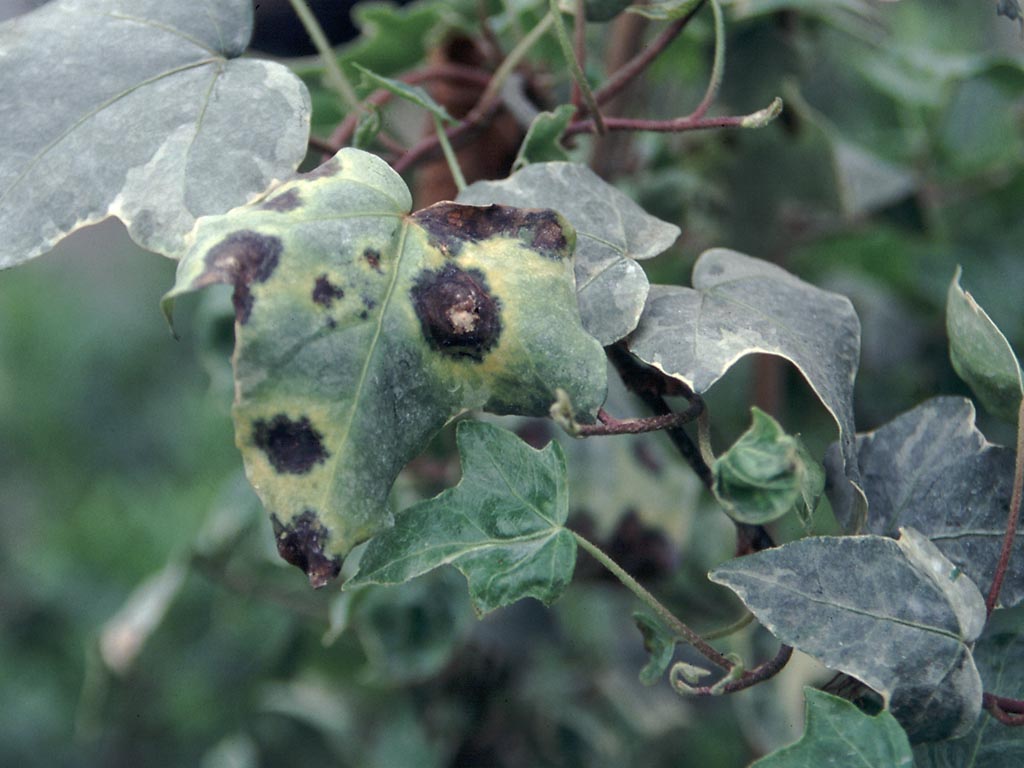Please click here to access the main AHDB website and other sectors.
- Home
- Knowledge library
- Bacterial leaf spot of ivy
Bacterial leaf spot of ivy
Bacterial leaf spot of ivy is caused by Xanthomonas hortorum pv. hederae. This page provides information on the symptoms, pathogen, biology and control of this disease, relevant for UK growers.
This information was last updated in 2023.
 S J Roberts
S J Roberts
An ivy leaf showing bacterial leaf spot symptoms.
An important disease of ivy
Ivies are widely grown as climbers, ground-cover, or houseplants. Bacterial leaf spot (Xanthomonas hortorum pv. hederae) causes significant losses for commercial growers of ivies (Hedera spp). Plants become unsaleable due to poor appearance, defoliation and dieback. The problems experienced by some growers have been so severe that they have ceased production of ivies.
Key points
- Bacterial leaf spot of ivy is caused by Xanthomonas hortorum pv. hederae (previously Xanthomonas campestris pv. hederae) (Xhh) .
- Irregular dark or black spots on leaves with water-soaked margin and yellow halo .
- The primary source of inoculum is the stock or mother plants.
- The disease is disseminated with cuttings, plug plants, liners.
- Local plant-to-plant spread is mainly via water-splash or aerosols from rain or irrigation.
Recommendations for ivy propagators
- Keep stock plants separate from production.
- Grow stock plants under protection with sub-irrigation.
- Test parental material for the presence of Xhh: remove and destroy any that are positive.
- Only take cuttings from plants which are known to be free from Xhh.
- Do not take cuttings from parental material where any have visible symptoms.
- Clean and disinfect hands, secateurs/knives between different stock plants and batches.
- Do not mix cuttings/plants from different sources.
Recommendations for ivy growers
- Xhh may be present on plug plants or liners in the absence of symptoms.
- Growers should press young plant suppliers for assurances of the health status of plug plants or liners.
- Quarantine and carefully check bought-in plants for the presence of symptoms, on arrival and for the next few weeks; reject the entire batch if there are symptoms on any plants.
- Grow batches of plants from different sources as far apart as possible.
- Do not mix batches of over-wintered and current season's production on the same beds.
- Use as wide a plant spacing as economically possible.
- Avoid or minimise overhead watering: use drip or capillary irrigation systems.
- Minimise the movement of people, equipment, and machinery within and between crop batches especially when plants are wet.
- Wash/disinfect hands when moving between susceptible crops.
- Clean and disinfect cutting and pruning tools frequently.
- Carry out trimming and pruning during dry weather and when it is forecast to remain so for a few days after the operation.
- Remove and destroy plants showing symptoms. This is particularly important with batches which remain unsold due to presence of disease – get rid of them quickly!
Symptoms and biology
Find out more about the symptoms of this disease and how to identify it, as well as its epidemiology.
Prevention and control
Bacterial diseases are very difficult to control once disease has become established in a crop and symptoms are widespread. The best means of control is prevention through the use of clean (pathogen-free) propagation/planting material and good nursery hygiene.
Useful links
Research project CP 174: Review of bacterial pathogens of economic importance to UK crops
Research project CP 191: looking at Improved Management of Bacterial Diseases in Horticultural Crops
Final report for research project HNS 91: Bacterial diseases of HNS: Chemical control
Download the final report from HNS 92: Hedera - Biology and epidemiology of Xanthomonas leaf spot
Download the factsheet: Bacterial diseases of herbaceous perennials
Download the factsheet: Bacterial diseases of protected ornamentals
Author
Dr Steven J. Roberts, Plant Health Solutions Ltd., Warwick, UK.
Topics:
Sectors:
Tags:

